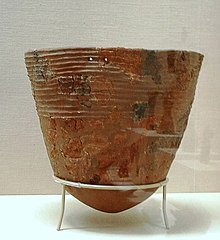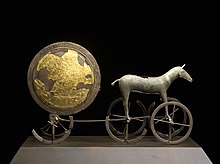


Nahal Hever Canyon, Israel Museum, Jerusalem
The three-age system is the periodization of human prehistory (with some overlap into the historical periods in a few regions) into three time-periods: the Stone Age, the Bronze Age, and the Iron Age,[1][2] although the concept may also refer to other tripartite divisions of historic time periods. In history, archaeology and physical anthropology, the three-age system is a methodological concept adopted during the 19th century according to which artefacts and events of late prehistory and early history could be broadly ordered into a recognizable chronology. C. J. Thomsen initially developed this categorization in the period 1816 to 1825, as a result of classifying the collection of an archaeological exhibition chronologically – there resulted broad sequences with artefacts made successively of stone, bronze, and iron.
The system appealed to British researchers working in the "science" of ethnology – they adopted it to establish race sequences for Britain's past based on cranial types. Although the craniological ethnology that formed its first scholarly context does not have modern scientific value, the relative chronology of the Stone Age, the Bronze Age and the Iron Age remains in use in a general public context,[3][4] and the three-ages concept underpins prehistoric chronology for Europe, the Mediterranean world and the Near East.[5]
The structure reflects the cultural and historical background of Mediterranean Europe and the Middle East. It soon underwent further subdivisions, including the 1865 partitioning of the Stone Age into Palaeolithic and Neolithic periods by John Lubbock.[6] The schema, however, has little or no utility for establishing chronological frameworks in sub-Saharan Africa, much of Asia, the Americas, and some other areas; and has little importance in contemporary archaeological or anthropological discussion for these regions.[7]
| Part of a series on |
| Human history and prehistory |
|---|
| ↑ before Homo (Pliocene epoch) |
| ↓ Future (Holocene epoch) |
- ^ Kipfer, Barbara Ann (30 April 2000). Encyclopedic Dictionary of Archaeology. New York: Springer Science & Business Media (published 2000). p. 564. ISBN 9780306461583. Retrieved 29 January 2021.
Three-Age system: The division of human prehistory into three successive stages - Stone Age, Bronze Age, and Iron Age - based on the main type of material used in tools of the period. [...] The Ages are only developmental stages, and some areas skipped one or more of the stages. At first entirely hypothetical, these divisions were later confirmed by archaeological observations.
- ^ Darvill, Timothy (19 August 2021), "Three Age System", The Concise Oxford Dictionary of Archaeology, Oxford University Press, doi:10.1093/acref/9780191842788.001.0001, ISBN 978-0-19-184278-8, archived from the original on 9 March 2022, retrieved 9 March 2022
- ^ Morse, Michael A. (1999). "Craniology and the Adoption of the Three-Age System in Britain". Proceedings of the Prehistoric Society. 65. Cambridge Press: 1–16. doi:10.1017/S0079497X00001924. S2CID 161193807. Archived from the original on 9 August 2018. Retrieved 27 December 2016.
- ^ Julian Richards (24 January 2005). "BBC – History – Notepads to Laptops: Archaeology Grows Up". BBC. Archived from the original on 25 April 2016. Retrieved 27 December 2016.
- ^ "Three-age System – Oxford Index". Oxford Index. Archived from the original on 16 September 2018. Retrieved 27 December 2016.
- ^ "John Lubbock's "Pre-Historic Times" is Published (1865)". History of Information. Archived from the original on 12 June 2017. Retrieved 27 December 2016.
- ^ "About the three Age System of Prehistory Archaeology". Act for Libraries. Archived from the original on 14 July 2019. Retrieved 27 December 2016.